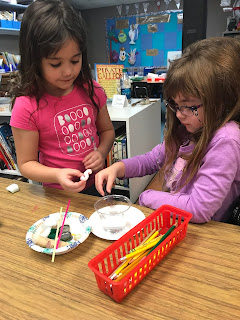How do we use the magnetic force in navigation?
That was the question of the week.
First of all, we experimented with the force.
What "sticks" to a magnet and what does not?
Then we felt the force.
Sometimes the force attracts. Other times it repels.
These are important scientific words to know.
We can make cool things using the force.
Sometimes the force is like magic!
Then we saw the force.
We looked at iron shavings being affected by the north and south poles of a bar magnet.
We wondered why the earth also has north and south poles.
We then discovered that the earth has north and south poles
because it is a giant magnet.
It was a wonderful light bulb moment!
We used the force to make magnetic compasses.
Instead of cookie cutter compasses, each student decided what materials to use. There was a lot of trial and error in the process and a lot of learning happening.
We rubbed a needle on a magnet 100 times to make the atoms north and south poles line up.
We discovered that corks and packing peanuts float well.
AND IT WORKED!
OUR NEEDLES POINTED TO THE NORTH POLE!
We discovered the secret (and the scientific reason) for how navigators (including Christopher Columbus) use magnetic compasses to figure out where they are in the world.
For Seabury's first grade Navigators, this might be very useful someday, as we are learning to navigate the world around us!















No comments:
Post a Comment